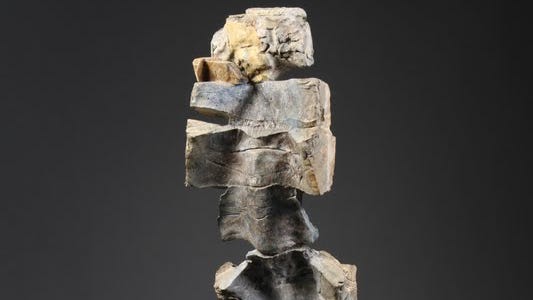Matter + Spirit: The Sculpture of Stephen De Staebler
Nov 16, 2011
Stephen De Staebler, Thorax Figure, 2008. Pigmented stoneware, porcelain, and earthenware, with surface oxides, fire brick, and stone, 68 x 17 x 16 in. (172.7 x 43.2 x 40.6 cm). Courtesy of Dolby Chadwick Gallery, San Francisco. Artwork © Estate of Stephen De Staebler. Photo credit: Scott McCue, courtesy of Dolby Chadwick Gallery, San Francisco
Approximately 55 ceramic and bronze works spanning the career of sculptor Stephen De Staebler (1933–2011) will be installed in the American art galleries at the de Young Museum from January 14 to April 22, 2012. Matter + Spirit: The Sculpture of Stephen De Staebler and its accompanying monograph commemorate the life and work of the renowned Bay Area artist, who died earlier this year in his Berkeley home.
For more than 50 years, De Staebler created figurative sculptures from clay—a medium that derives from the primordial earth. Drawing inspiration from childhood experiences with nature, a transformative adolescent encounter with human mortality, and adult studies in the history of art and religion, he explored and extended a tradition of human representation that includes the religious monuments of ancient Egypt, the Renaissance humanism of Michelangelo’s finished and unfinished figures, and the modern existentialism embodied in the works of Alberto Giacometti.
De Staebler’s diverse artistic ancestors were linked by their engagement with universal aspects of the human condition, including struggle, suffering, and the search for meaning. The validity of this engagement was seriously challenged during World War II, when the human body—and even humanity itself—seemed to be threatened with extinction. Maturing as an artist in the decades following the War, De Staebler thus confronted the challenge of whether art—and the human figure—retained any relevance in a world that had been forever altered by the Holocaust and by Hiroshima and Nagasaki. Compounding the problem, belief in the existence of a higher spiritual power was also called into question by these cataclysmic events.
In the ensuing decades, De Staebler devoted his sculptural practice in clay and bronze to resurrecting the human figure as the most natural vessel for humanity and spirituality. His figures embody modern existential experience, in which the solitary individual feels physically, psychically, or spiritually fragmented and alienated from the contemporary world. These sculptures offer equivocal rather than definitive statements regarding the human condition. They focus instead on the transitional or metamorphic states that lie between nature and culture, life and death, integration and disintegration, and matter and spirit.
De Staebler’s sculptures are individual acts of faith—and doubt—shaped by a spiritual seeker and questioning skeptic who is working to reconcile his intellect and experience with his emotions and beliefs. As he observed, the human figure, “is obviously the most loaded of all forms because we live in one. The figure obsesses not just artists, but human beings. It’s our prison. It’s what gives us life and also gives us death.”
Timothy Anglin Burgard, the Ednah Root Curator of American Art at the de Young Museum, reflects on this rich synthesis of existential alienation and spiritual aspiration that De Staebler masterfully achieves in his art:
De Staebler’s creation of his sculptures was inherently an act of affirmation, yet the artworks offer equivocal rather than definitive statements. They focus instead on the transitional or metamorphic states that lie between nature and culture, life and death, integration and disintegration, and matter and spirit. They thus manifest the pervasive dilemma of existential doubt while also serving as rare sanctuaries for humanist values and spiritual beliefs in an increasingly materialist age.
The Artist
Born in Saint Louis, Missouri, in 1933, Stephen De Staebler studied religion at Princeton University and fine art at U.C. Berkeley. An important contributor to the evolution of the California Clay and Bay Area Figurative movements, and a key figure who helped to sustain the relevance of figurative sculpture in the post-World War II period, De Staebler was an influential teacher at San Francisco State University and the San Francisco Art Institute. His work resides in numerous museum collections, including the Metropolitan Museum of Art, New York; the Museum of Fine arts, Boston; the Los Angeles County Museum of Art; and the Fine Arts Museums of San Francisco.
The Catalogue
Matter + Spirit: Stephen De Staebler is a timely tribute to a pioneering artist and his enduring work. Produced in collaboration with the artist and drawing upon the extensive archives of his estate, this authoritative volume is published on the occasion of the exhibition at the de Young Museum. Lavishly illustrated with artworks and archival materials, many of them never before published, it traces De Staebler’s prolific oeuvre from his early anthropomorphic landscape sculptures, through his well-known standing figure columns and bronze angels, to late assemblage pieces created from fragments of earlier works in the artist’s “boneyard.” Offering an unprecedented glimpse into the sculptor’s studio and working process, this catalogue is replete with new scholarship and fascinating discoveries. Illuminating the significance of De Staebler’s practice as never before, a comprehensive essay by exhibition curator Timothy Anglin Burgard provides in-depth analysis of the artist’s entire career, highlighting persistent themes within major sculptures. Poet and scholar Rick Newby sketches a biographical portrait of the sculptor, documenting how De Staebler’s life was remarkably reflected in his art. Art historian Dore Ashton offers a moving tribute to the artist she met in the 1970s and with whom she remained a lifelong friend.
Organization
Matter + Spirit: The Sculpture of Stephen De Staebler has been organized by the Fine Arts Museums of San Francisco. Lead Sponsors are Lorna Meyer Calas and Dennis Calas. Sponsors are Dolby Chadwick Gallery, Beverly and Peter Lipman, Dorothy Saxe, and David and Roxanne Soward. Additional support has been provided by Lisa and Patrick Denzer. The catalogue is published with the assistance of the Andrew W. Mellon Foundation Endowment for Publications.
